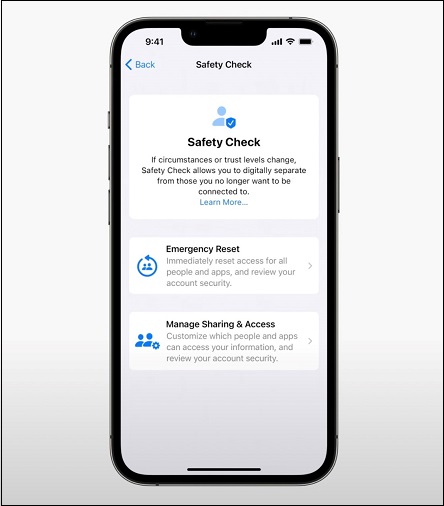People looking to leave abusive relationships have a new tool to assist, after Apple introduced a new tool for disconnecting from partners as part of its far-reaching annual announcement of new features in iOS and its other platforms.
The new Safety Check feature, announced at the WorldWide Developers Conference (WWDC) where Apple annually debuts new features to the developers that build apps for its devices, offers a new section in the iOS 16 Settings menu where users can review and revoke all of the ways they have granted access to other people.
Such access is often provided casually, such as when partners share photo libraries, messaging accounts, device passwords, location tracking, and more.
But when the relationship turns bad, that access is often abused by one partner to keep tabs on the other – making it hard for them to flee a violent living situation to seek shelter, or restart their lives somewhere else.
“Many people share passwords and access to their devices with their partner,” Apple senior manager for user privacy software Katie Skinner said in announcing the new feature.
“However, in abusive relationships this can threaten personal safety and make it harder for victims to get help… [Safety Check] lets people in abusive situations quickly revoke an abuser’s access to their data and location, enabling them to cut ties and get to safety.”
Safety Check automatically stops sharing your location with other people, resets system privacy permissions for all apps on the user’s phone, and signs the user out of iCloud on every device but the one in their hands – preventing a prying partner from logging on using their password, or keeping tabs on their communications and movements using an iPad that has been left behind.
The use of ‘stalkerware’ increased dramatically during the first few months of the COVID-19 pandemic, according to one Avast analysis, which noted that during 2020 the baseline of around 10,000 stalkerware attacks per month surged to over 53,000 per month, on average.
That included an average 517 infections per month in Australia alone, where a lack of legal protections has continued despite legal changes mooted years ago.
That has left many victims forced to try to defend their technology against often-determined partners, and response to the Safety Check feature has been strong, Skinner said, quoting the National Center for Victims of Crime (NCVC) – which, along with NNEDC and Australia’s WESNET, worked with Apple to design the feature – as saying that ‘In times of crisis, for many survivors, it’s important to know who has their information and location…. Safety Check helps give control back to survivors.”

Overhauling Apple’s look and feel
The Safety Check feature is just one of dozens of new capabilities highlighted by Apple at the launch, where Apple feted the features of iOS 16, including highly customisable lock screens, widgets that show key information at a glance, and a Messages feature that allows users to edit messages they’ve regretted sending.
The company also debuted the forthcoming ‘Ventura’ version of macOS; updated its MacBook Air with a new M2 CPU; and provided a host of new features that let app developers tap the capabilities of its devices.
The company also debuted major changes to the look and feel of its iPhones, iPads, Apple Watch, and more, as well as launching a buy-now-pay-later extension to its Apple Pay ecosystem called Pay Later that has many consumer advocates concerned.
It's all part of what Dr Billy Sung, a retail and consumer psychologist with Curtin University’s School of Management and Marketing, calls an ‘incremental innovation’ strategy – based on software innovation – that Apple has embraced, “as hardware hasn’t seen much of an innovative leap and it realises that the hardware market is saturating.”
“Apple is deviating its marketing strategy and research and development on software,” Sung said. “By adding more unique functionality into their software and differentiating them from competitors, Apple hopes to retain existing customers and attract new customers.”










